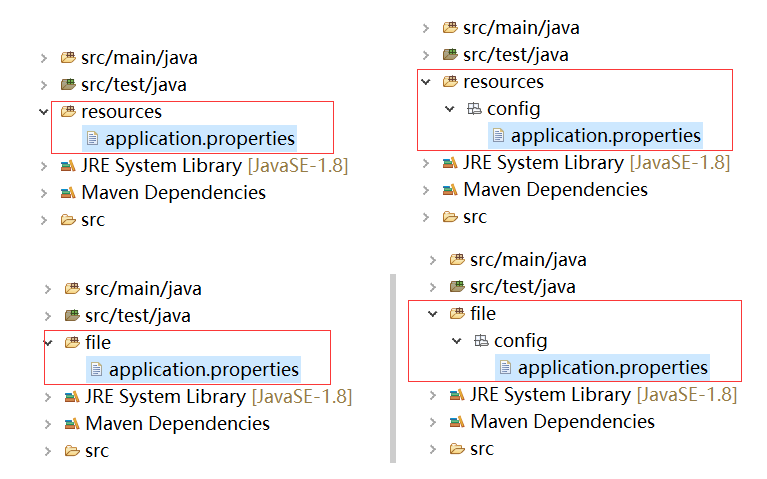(一)配置文件中取值
springboot的默认配置文件是application.properties或者application.yml。读取配置文件有以下两种方式
1、注入Environment对象,用Environment对象获取
2、使用Value注解
获取的值默认都是字符串类型,使用Value注解时,自动转化类型,使用Environment对象时,指定类,如下:
pom.xml

<?xml version="1.0" encoding="UTF-8"?> <project xmlns="http://maven.apache.org/POM/4.0.0" xmlns:xsi="http://www.w3.org/2001/XMLSchema-instance" xsi:schemaLocation="http://maven.apache.org/POM/4.0.0 http://maven.apache.org/xsd/maven-4.0.0.xsd"> <modelVersion>4.0.0</modelVersion> <groupId>com.edu.spring</groupId> <artifactId>springboot</artifactId> <version>1.0.0</version> <packaging>jar</packaging> <name>springboot</name> <!-- FIXME change it to the project's website --> <url>http://www.example.com</url> <dependencyManagement> <dependencies> <dependency> <groupId>org.springframework.boot</groupId> <artifactId>spring-boot-dependencies</artifactId> <version>2.1.6.RELEASE</version> <scope>import</scope> <type>pom</type> </dependency> </dependencies> </dependencyManagement> <properties> <project.build.sourceEncoding>UTF-8</project.build.sourceEncoding> <maven.compiler.source>1.8</maven.compiler.source> <maven.compiler.target>1.8</maven.compiler.target> </properties> <dependencies> <dependency> <groupId>org.springframework.boot</groupId> <artifactId>spring-boot-starter</artifactId> </dependency> </dependencies> </project>
UserConfig.java

package com.edu.spring.springboot; import org.springframework.beans.factory.annotation.Autowired; import org.springframework.beans.factory.annotation.Value; import org.springframework.core.env.Environment; import org.springframework.stereotype.Component; @Component public class UserConfig { @Autowired private Environment environment; @Value("${local.port}") private String port; @Value("${local.port}") private Integer port2; public void show(){ System.out.println("local.ip= "+environment.getProperty("local.ip")); System.out.println("local.port= "+environment.getProperty("local.port",Integer.class)); System.out.println("local.port= "+port); System.out.println("local.port= "+port2); } }
App.java

package com.edu.spring.springboot; import org.springframework.boot.SpringApplication; import org.springframework.boot.autoconfigure.SpringBootApplication; import org.springframework.context.ConfigurableApplicationContext; @SpringBootApplication public class App { public static void main( String[] args ) { ConfigurableApplicationContext context=SpringApplication.run(App.class, args); System.out.println(context.getEnvironment().getProperty("local.ip")); context.getBean(UserConfig.class).show(); context.close(); } }
运行结果如下:

假如在配置文件中没对应的属性,取值的时候可以指定默认值,即配置文件中存在属性,取配置文件中的,否则取指定的。如下:
UserConfig.java

package com.edu.spring.springboot; import org.springframework.beans.factory.annotation.Autowired; import org.springframework.beans.factory.annotation.Value; import org.springframework.core.env.Environment; import org.springframework.stereotype.Component; @Component public class UserConfig { @Autowired private Environment environment; @Value("${name:你好}") private String name; public void show(){ System.out.println("name= "+environment.getProperty("name","你好")); System.out.println("name= "+name); } }
App.java

package com.edu.spring.springboot; import org.springframework.boot.SpringApplication; import org.springframework.boot.autoconfigure.SpringBootApplication; import org.springframework.context.ConfigurableApplicationContext; @SpringBootApplication public class App { public static void main( String[] args ) { ConfigurableApplicationContext context=SpringApplication.run(App.class, args); context.getBean(UserConfig.class).show(); context.close(); } }
运行结果如下:

springboot的默认配置文件可以放在classpath、classpath:/config、file、file:/config下面(file可以是任意名字),如下图所示:

(二)读取指定的配置文件
1、使用@PropertySource指定配置文件路径和名称,该注解可以多次使用,如下:
配置文件共4个

application.properties内容:url4=jdbc:mysql:localhost:3306/springboot4
jdbc.properties内容:url1=jdbc:mysql:localhost:3306/springboot1
jdbc2.properties内容:url2=jdbc:mysql:localhost:3306/springboot2
jdbc3.properties内容:url3=jdbc:mysql:localhost:3306/springboot3
FileConfig.java

package com.edu.spring.springboot; import org.springframework.context.annotation.Configuration; import org.springframework.context.annotation.PropertySource; @Configuration @PropertySource("classpath:jdbc.properties") @PropertySource("classpath:jdbc2/jdbc2.properties") @PropertySource("file:/d:/1_1test/jdbc3.properties") public class FileConfig { }
JdbcConfig.java

package com.edu.spring.springboot; import org.springframework.beans.factory.annotation.Value; import org.springframework.stereotype.Component; @Component public class JdbcConfig { @Value("${url1}") private String url1; @Value("${url2}") private String url2; @Value("${url3}") private String url3; @Value("${url4}") private String url4; public void show(){ System.out.println("url1: "+url1); System.out.println("url2: "+url2); System.out.println("url3: "+url3); System.out.println("url4: "+url4); } }
App.java

package com.edu.spring.springboot; import org.springframework.boot.SpringApplication; import org.springframework.boot.autoconfigure.SpringBootApplication; import org.springframework.context.ConfigurableApplicationContext; @SpringBootApplication public class App { public static void main( String[] args ) { ConfigurableApplicationContext context=SpringApplication.run(App.class, args); context.getBean(JdbcConfig.class).show(); context.close(); } }
运行结果如下:

2、使用@PropertySources一次指定所有的配置文件
FileConfig.java

package com.edu.spring.springboot; import org.springframework.context.annotation.Configuration; import org.springframework.context.annotation.PropertySource; import org.springframework.context.annotation.PropertySources; @Configuration @PropertySources({@PropertySource("classpath:jdbc.properties"),@PropertySource("classpath:jdbc2/jdbc2.properties"), @PropertySource("file:/d:/1_1test/jdbc3.properties")}) public class FileConfig { }
运行结果如下:

(三)自动配置文件中的前缀
使用@ConfigurationProperties注解中的属性prefix或者value可以指定属性的前缀,结合属性的set方法可以取到配置文件中的属性值,如下:
application.properties

ds.url=jdbc:mysql:localhost:3306/springboot; ds.driverClassName=com.mysql.jdbc.Driver; ds.username=asdf; ds.password=123456;
DataSourceProperties.java

package com.edu.spring.springboot; import org.springframework.boot.context.properties.ConfigurationProperties; import org.springframework.stereotype.Component; @Component @ConfigurationProperties(value="ds") public class DataSourceProperties { private String url; private String driverClassName; private String username; private String password; public void setUrl(String url) { this.url = url; } public void setDriverClassName(String driverClassName) { this.driverClassName = driverClassName; } public void setUsername(String username) { this.username = username; } public void setPassword(String password) { this.password = password; } public void show(){ System.out.println("--------------DataSourceProperties---------------"); System.out.println("ds.url: "+url); System.out.println("ds.driverClassName: "+driverClassName); System.out.println("ds.username: "+username); System.out.println("ds.password: "+password); } }
App.java

package com.edu.spring.springboot; import org.springframework.boot.SpringApplication; import org.springframework.boot.autoconfigure.SpringBootApplication; import org.springframework.context.ConfigurableApplicationContext; @SpringBootApplication public class App { public static void main( String[] args ) { ConfigurableApplicationContext context=SpringApplication.run(App.class, args); context.getBean(DataSourceProperties.class).show(); context.close(); } }
运行结果如下:

(四)读取数组或者集合
application.properties

ds.hosts[0]=192.168.1.100 ds.hosts[1]=192.168.1.101 ds.hosts[2]=192.168.1.102 ds.sports[0]=8080 ds.sports[1]=8081 ds.sports[2]=8082 ds.sports[3]=8083
TomcatProperties.java

package com.edu.spring.springboot; import java.util.ArrayList; import java.util.Arrays; import java.util.List; import org.springframework.boot.context.properties.ConfigurationProperties; import org.springframework.stereotype.Component; @Component @ConfigurationProperties("ds") public class TomcatProperties { private List<String> hosts=new ArrayList<String>(); private String[] sports; public void setHosts(List<String> hosts) { this.hosts = hosts; } public void setSports(String[] sports) { this.sports = sports; } @Override public String toString() { return "TomcatProperties [hosts=" + hosts + ",sports="+Arrays.asList(sports)+"]"; } }
App.java

package com.edu.spring.springboot; import org.springframework.boot.SpringApplication; import org.springframework.boot.autoconfigure.SpringBootApplication; import org.springframework.context.ConfigurableApplicationContext; @SpringBootApplication public class App { public static void main( String[] args ) { ConfigurableApplicationContext context=SpringApplication.run(App.class, args); System.out.println(context.getBean(TomcatProperties.class)); context.close(); } }
运行结果如下:

(四)启动时指定不同的配置文件
resources中有三个配置文件,如下图所示:

application.properties中内容:url=mysql:jdbc://127.0.0.1/db_springboot
application-test.properties中内容:url=mysql:jdbc://127.0.0.1/db_springboot_test
application-dev.properties中内容:url=mysql:jdbc://127.0.0.1/db_springboot_dev
App.java

package com.edu.spring.springboot; import org.springframework.boot.SpringApplication; import org.springframework.boot.autoconfigure.SpringBootApplication; import org.springframework.context.ConfigurableApplicationContext; @SpringBootApplication public class App { public static void main( String[] args ) { SpringApplication app=new SpringApplication(App.class); app.setAdditionalProfiles("test"); ConfigurableApplicationContext context=app.run(args); System.out.println(context.getEnvironment().getProperty("url")); context.close(); } }
运行结果如下:

如果代码中的"test"修改为"dev",则读取application-dev.properties中的url属性
如果注释掉代码中的app.setAdditionalProfiles行,则读取application.properties中的url属性
app.setAdditionalProfiles可以指定多个文件,如下:
添加配置文件application-aa.properties,内容是:name=hello application-aa.properties
App.java

package com.edu.spring.springboot; import org.springframework.boot.SpringApplication; import org.springframework.boot.autoconfigure.SpringBootApplication; import org.springframework.context.ConfigurableApplicationContext; @SpringBootApplication public class App { public static void main( String[] args ) { SpringApplication app=new SpringApplication(App.class); app.setAdditionalProfiles("dev","test","aa"); ConfigurableApplicationContext context=app.run(args); System.out.println(context.getEnvironment().getProperty("url")); System.out.println(context.getEnvironment().getProperty("name")); context.close(); } }
运行结果如下:

备注:同时加载多个配置文件,且文件中有相同的属性时,则取后加载的,如同时加载了"dev"与"test",则取"test"中的url。
